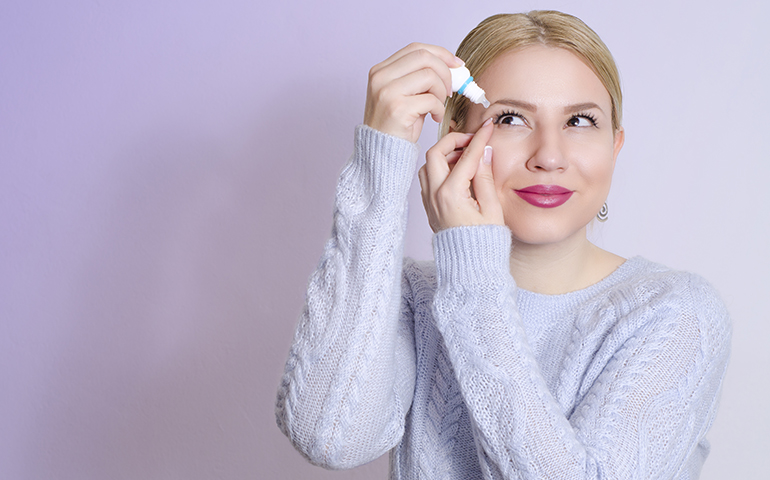
Can you use eye drops with contact lenses?
Whether they are for dry eyes, allergies or infections, there are a variety of eye drops available to treat minor and major conditions. But if you are wearing contact lenses and don’t want to miss the convenience of these by switching to glasses, the choice becomes a bit more limited.
Some eye drops can be used while wearing contact lenses, while others are not suited for contact lens wearers. The latest generation soft contact lenses are typically designed to reduce deposit build-up and prevent dust and dirt from sticking to the surface, but the oils and preservatives of certain eye drops tend permeate into contact lenses. This can cause discomfort and irritation, as well as cloudy vision.
With many different types of eye drops available not only per prescription but also over the counter, it is always best to consult your optometrist and find out which eye drops are best suited for your requirements and treat the condition at hand.
Prescription vs over the counter
Some may be unsure whether to buy eye drops over the counter or discuss options with their optometrist or GP. The difference between eye drops bought over the counter and those obtained by prescription is the amount of active ingredients as well as the purpose of the drops.
Prescription eye drops have more active medical ingredients than over-the-counter products. While over-the-counter drops are typically a good option to relieve minor ailments, products that treat chronic conditions, serious infections and conditions require a prescription.
For eye drops treating dry eyes and minor conditions, both over-the-counter and those on prescription offer options that can be used while wearing contact lenses as well as options that are not suitable for lens wearers.
It is always recommended to ask your optician for advice on which eye drops are suitable for you.
Types of eye drops
The large variety of products available ensures that you find a treatment option for your issue or at least a short-term solution.
Antibiotic eye drops
In the UK, certain antibiotic eye drops, or eye ointments can only be obtained when prescribed by a GP or eye care professional. They are used to treat eye infections such as conjunctivitis (pink eye). They heal and prevent infections by killing the bacteria causing them.
While treating an eye infection with antibiotic eye drops, you should not wear contact lenses.
Allergy relief
Allergy sufferers often have ocular symptoms, such as itchy, dry or red eyes, which are caused by irritants. A large variety of allergy eye drops is available as over-the-counter options or by prescription for those with severe symptoms.
Anti-allergy eye drops should not be used when wearing contact lenses; however, your optometrist can advise on the best solution for you.
Lubricating and re-wetting
Re-wetting eye drops, or artificial tears are used to lubricate dry eyes, whether these were caused by environmental factors, age, or medication. Many brands offer lubricating eye drops without a prescription, but those who suffer from chronic dry eye disease may find prescription eye drops better suited for them. In either case, it is recommended to discuss your options with an eye care specialist, as they are able to recommend a brand that is best suited to treat your eyes.
Re-wetting drops are often labelled as suitable for contact lens wearers, as these are developed without preservatives and can moisturise eyes during contact lens wear.
Red-eye reducing
Visible red veins in the eyes can be caused by several catalysts, such as allergies, stress, or infections. If the redness is not accompanied by irritation or soreness, some may wish to simply relieve the redness, rather than treat the initial cause for it. Redness relieving eye drops reduce visible blood vessels, but if used frequently can also cause the opposite result and irritate your eyes further.
Therefore, they are not recommended to be used when wearing contact lenses, as the active ingredients absorb into the lens and stay on the eyes longer, which may cause them to become redder and more irritated than before.

Risks when using eye drops with contact lenses
There are many different brands of eye drops that are suitable for use with contact lenses, but what can happen if you accidentally apply the wrong type of eye drops while wearing lenses?
Irritation
Some eye drops may cause a stinging or burning sensation due to preservatives. Ask your optician whether options without preservatives are available for you.
Blurry vision
Depending on the types of eye drops you used, they may contain oils or other additives that can stick to contact lenses. The drops may cause a film to build up over the contact lenses, which can cause blurred or cloudy vision.
If you are unsure whether the eye drops you purchased are suitable for use with lenses, you can always ask your optician for advice.
Eye drops or contact lens solution
Eye drops and contact lens solution are both clear liquids that are safe and beneficial to your eye health, but they are not the same and should not be used interchangeably.
Replacing solution with rewetting eye drops
Contact lens solution is designed to disinfect and moisturise contact lenses, whereas rewetting drops are developed to lubricate the eyes. As eye drops don’t have any disinfecting benefits and are unable to remove protein, lipids or debris from the lenses, storing them in eye drops will increase the risk of infection.
Using solution to lubricate eyes
If you try using contact lens solution as eye drops to relieve dry eyes, the solution will not replenish the tear film and only offer minimal beneficial effects.
You also risk damaging the surface of your eyes. The nozzle of a bottle of contact lens solution is not designed to administer drops, and you may run the risk of scratching your cornea, which can cause further irritation.

Dry eyes
One of the most common reasons for people to gravitate towards eye drops is to keep their dry eyes lubricated. Apart from dry air in the winter times, medication or allergies, dry eyes may be caused by contact lenses or are a sign of chronic dry eye disease.
What to do if your contact lenses cause dry eyes
Before you start wearing contact lenses, you go through a contact lens fitting appointment with your optician. During this they examine your eye health and determine which lenses may be best suited for you. However, over time your eye health may change and with it the requirements for contact lenses.
If you feel like your contact lenses are causing your eyes to feel dry, try discussing a different option with your optometrist. Whether you switch to a silicone hydrogel or a daily lens type, or try using recommended re-wetting eye drops, your optometrist can advise you on the best option to relieve your eyes.
Chronic dry eye
Chronic dry eye syndrome is an eye condition that prevents the eyes from producing enough tears or is due to an instability in the tear film. It is often caused by age or other health conditions such as lupus, thyroid disorder or rheumatoid arthritis.
Depending on the severity of the condition, optometrists may either supply eye drops or ointments, lid wipes or hot compresses.
If conventional treatment does not work, your optometrist may recommend a referral to a dry eye specialist.